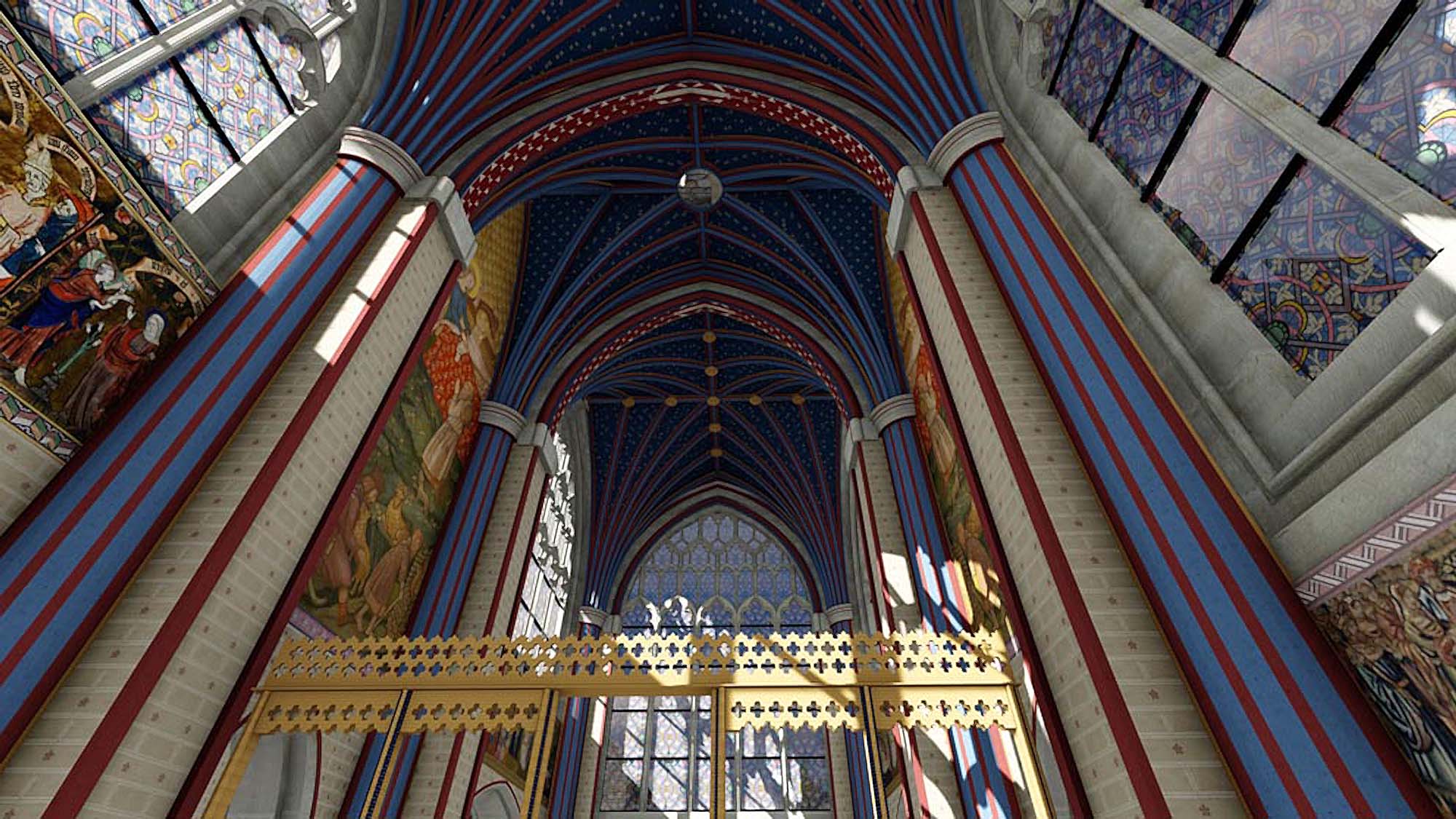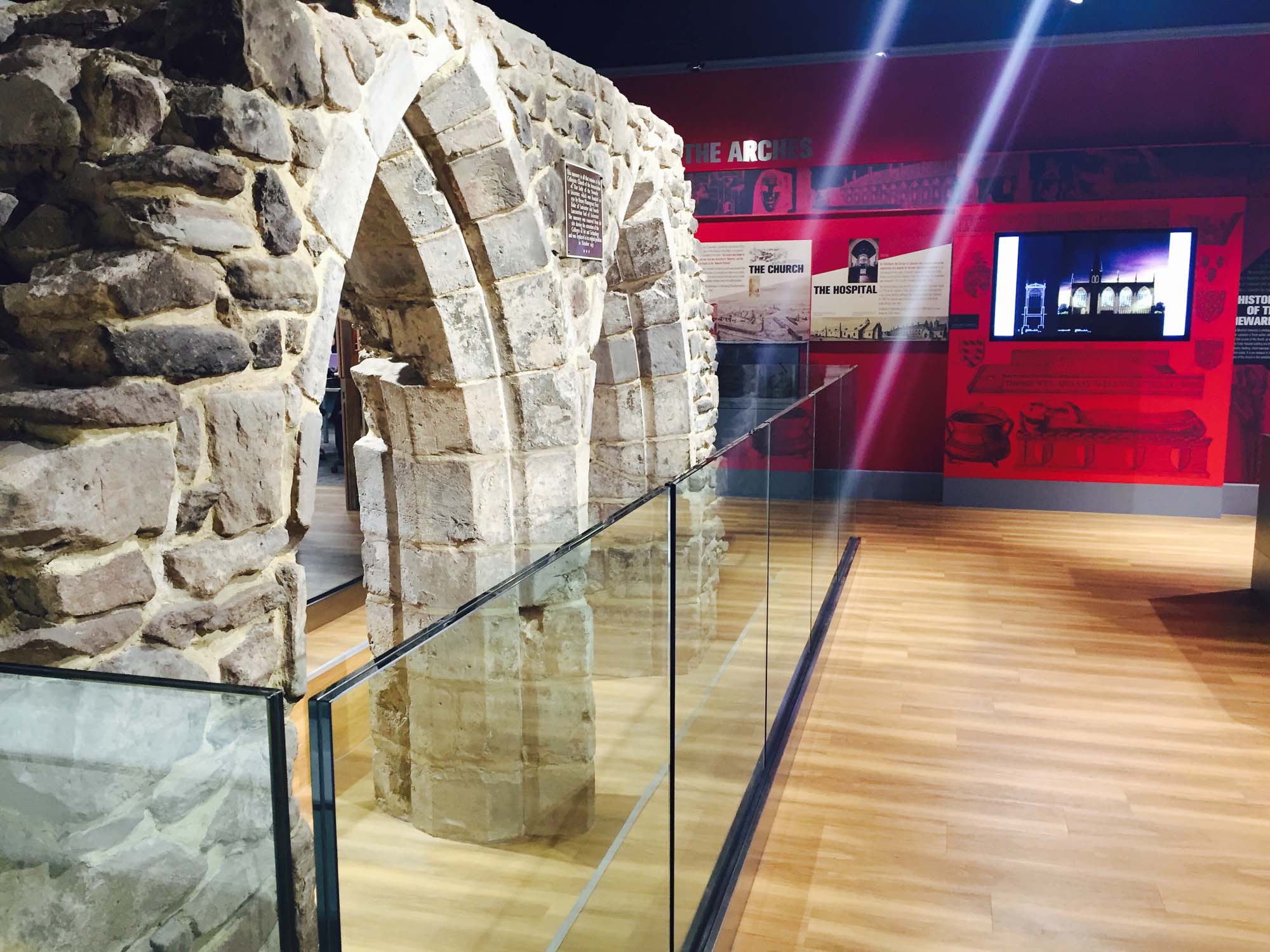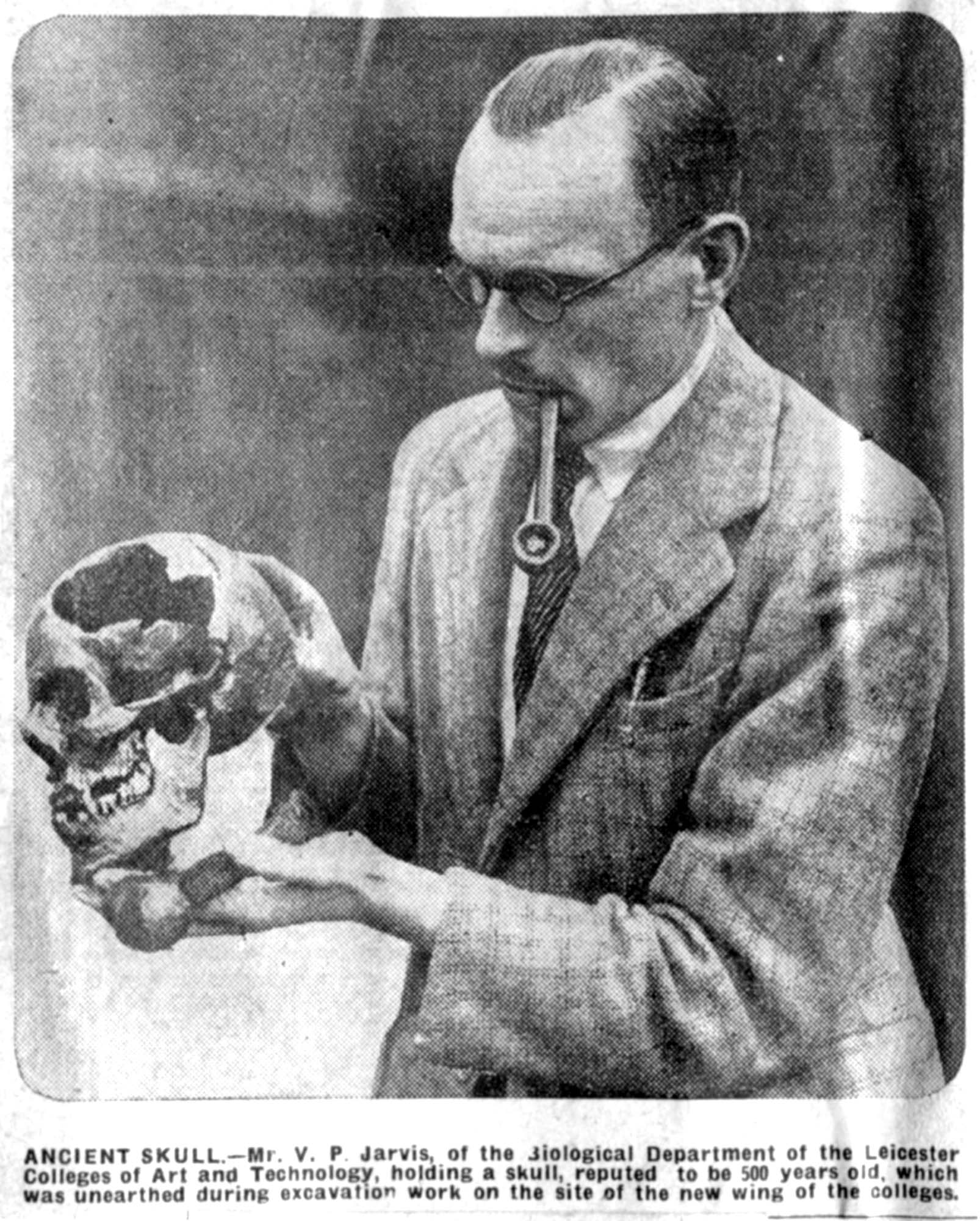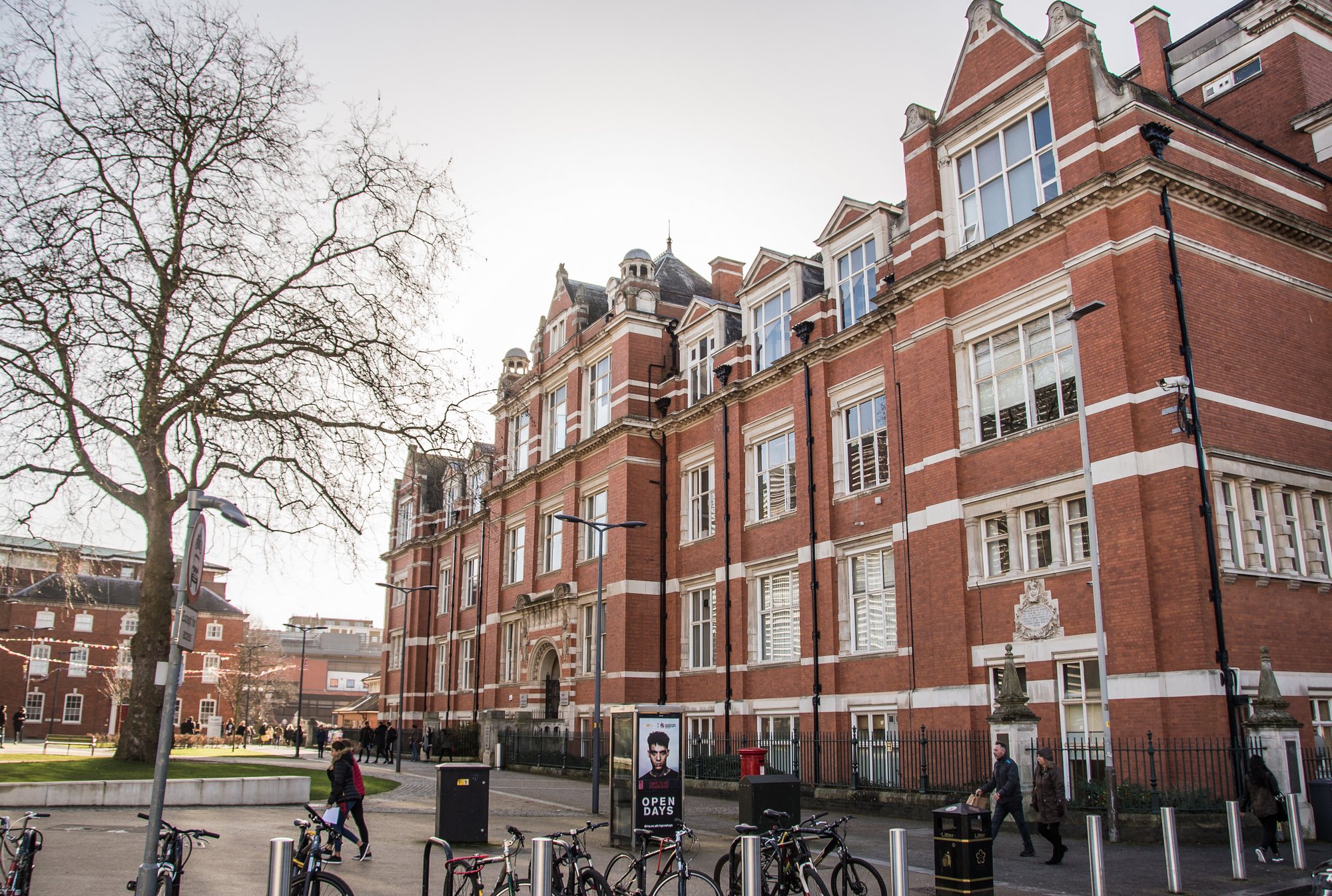The lord and important retainers would have sat at the north end of the hall, and in the centre of the building was a large open hearth. Doors at the north end led to the lord’s private apartments, whilst at the south end there was access to a separate kitchen above an undercoft (John of Gaunt’s cellar), where ale, wine and food would have been stored.
- Originally built to house a holy relic, reputed to be a thorn from the ‘crown of thorns’ said to have been worn by Jesus before his crucifixion
- The body of Richard III was publicly displayed here after he was killed at the Battle of Bosworth
- Walls and arches that were part of the church can be seen inside the De Montfort University Heritage Centre
Part of the De Montfort University Heritage Centre
In the basement of De Montfort Universities (DMU) Hawthorn Building, stand two arches which were once part of a medieval church. Today, these ruins form the centrepiece for the university’s Heritage Centre.
Built to house a holy relic
The Church of the Annunciation of the Blessed Virgin Mary was founded in 1353 by Henry the first Duke of Lancaster, son of the Henry who founded Trinity Hospital. Henry was one of King Edward III’s most trusted captains in the early phases of the Hundred Years’ War and earned himself a notable reputation. He was a founding member and the second Knight of the Order of the Garter, an order of chivalry founded by the king in 1348. Henry was was made a duke in 1351.

Upon returning from France, Henry enlarged his father's hospital foundation and built a new church to house a holy relic given to him by King John II of France; a thorn reputed to be from the ‘crown of thorns’ said to have been worn by Jesus before his crucifixion. The relic was housed in a reliquary (container) of gold at the altar and made the church a popular place of pilgrimage.
The church had a chantry function, meaning vicars would have prayed for the souls of the Lancastrian family - and for the souls of any local people who could afford to endow a chapel in the church.
After falling ill, Henry died at Leicester Castle in 1361 and he was buried in the Church of the Annunciation next to his father.
In fact, the church is nationally important as a site of Lancastrian burials as well as the site of the public exhibition of the body of King Richard III after his death at the battle of Bosworth in 1485. A chronicle in the British Library states: ‘they brought King Richard thither that night, as naked as ever he was born, and in the Newarke was he laid, that many a man might see.’
The Reformation
In 1548 the church was demolished during The Reformation and the land sold to private hands. A large house and gardens were constructed on the site, which had various prestigious owners including the Coltmans, a hosiery manufacturing family, and Edward Shipley Ellis, chairman of the Midland Railway Company.
Art school discovery
In 1897 the house and grounds were purchased by the Corporation of Leicester for construction of the Leicester Municipal Technical and Art School, now the Hawthorn Building of DMU. Construction took place over several years as each wing of the building was built separately. When the old house came to be demolished in 1935, two ruined arches from the Church of the Annunciation were discovered embedded into the wall of the cellar, along with many bones, coffins and architectural fragments. The arches were preserved and later incorporated into the Hawthorn Building where they can still be seen as the centrepiece of the DMU Heritage Centre.
The Heritage Centre showcases the story of The Newarke and how this historic location developed over the centuries. It also tells the story of the De Montfort University and hosts two temporary gallery spaces which change every six months, showcasing student and staff research as well as projects and collections from local partners.
The DMU Heritage Centre is open to the public, find out how to visit.
Gallery

DMU Heritage Centre

Leicester Mercury


DMU Digital Buildings Heritage Group
Richard III
Roman Leicester
(47- 500) A military fort was erected, attracting traders and a growing civilian community to Leicester (known as Ratae Corieltauvorum to the Romans). The town steadily grew throughout the reign of the Romans.
Medieval Leicester
(500 – 1500) The early years of this period was one of unrest with Saxon, Danes and Norman invaders having their influences over the town. Later, of course, came Richard III and the final battle of the Wars of the Roses was fought on Leicester’s doorstep.
-
The Castle Motte1068

-
Leicester Cathedral1086

-
St Mary de Castro1107

-
Leicester Abbey1138

-
Leicester Castle1150

-
Grey Friars1231

-
The Streets of Medieval Leicester1265

-
Leicester Market1298

-
Trinity Hospital and Chapel1330

-
Bow Bridgecirca 1350

-
Church of the Annunciation1353

-
John O’Gaunt’s Cellar1361

-
St John's Stone1381

-
Leicester Guildhall1390

-
The Magazine1400

-
The Blue Boar Inn1400

-
The High Cross1577

Tudor & Stuart Leicester
(1500 – 1700) The wool trade flourished in Leicester with one local, a former mayor named William Wigston, making his fortune. During the English Civil War a bloody battle was fought as the forces of King Charles I laid siege to the town.
Georgian Leicester
(1700 – 1837) The knitting industry had really stared to take hold and Leicester was fast becoming the main centre of hosiery manufacture in Britain. This new prosperity was reflected throughout the town with broader, paved streets lined with elegant brick buildings and genteel residences.
-
Great Meeting Unitarian Chapel1708

-
The Globe1720

-
17 Friar Lane1759

-
Black Annis and Dane Hills1764

-
Leicester Royal Infirmary1771

-
New Walk1785

-
Freemasons’ Hall1790

-
Gaols in the City1791

-
Friars Mill1794

-
City Rooms1800

-
Development of Highfields1800

-
Wesleyan Chapel1815

-
20 Glebe Street1820

-
Charles Street Baptist Chapel1830

-
Glenfield Tunnel1832

-
James Cook1832

Victorian Leicester
(1837 – 1901) The industrial revolution had a huge effect on Leicester resulting in the population growing from 40,000 to 212,000 during this period. Many of Leicester's most iconic buildings were erected during this time as wealthy Victorians made their mark on the town.
-
Leicester Union Workhouse1839

-
Campbell Street and London Road Railway Stations1840

-
The Vulcan Works1842

-
Belvoir Street Chapel1845

-
Welford Road Cemetery1849

-
Leicester Museum & Art Gallery1849

-
King Street1850

-
Cook’s Temperance Hall & Hotel1853

-
Amos Sherriff1856

-
Weighbridge Toll Collector’s House1860

-
4 Belmont Villas1862

-
Top Hat Terrace1864

-
Corah and Sons - St Margaret's Works1865

-
Kirby & West Dairy1865

-
The Clock Tower1868

-
Wimbledon Works1870

-
The Leicestershire Banking Company1871

-
St Mark’s Church and School1872

-
Victorian Turkish Baths1872

-
The Town Hall1876

-
Central Fire Stations1876

-
Aylestone Road Gas Works and Gas Museum1879

-
Gas Workers Cottages1879

-
Leicestershire County Cricket Club1879

-
Welford Road Tigers Rugby Club1880

-
Secular Hall1881

-
Development of Highfields1800

-
Abbey Park1881

-
Abbey Park Buildings1881

-
Victoria Park and Lutyens War Memorial1883

-
Leicester Fosse FC 18841884

-
Leicester Coffee and Cocoa Company Coffee Houses1885

-
St Barnabas Church and Vicarage1886

-
Abbey Pumping Station1891

-
Luke Turner & Co. Ltd.1893

-
West Bridge Station1893

-
Thomas Cook Building1894

-
The White House1896

-
Alexandra House1897

-
Leicester Boys Club1897

-
Grand Hotel and General Newsroom1898

-
Highfield Street Synagogue1898

-
Western Park1899

-
Asfordby Street Police Station1899

-
Leicester Central Railway Station1899

Edwardian Leicester
(1901 – 1910) Electric trams came to the streets of Leicester and increased literacy among the citizens led to many becoming politicised. The famous 1905 ‘March of the Unemployed to London’ left from Leicester market when 30,000 people came to witness the historic event.
-
YMCA Building1900

-
The Palace Theatre1901

-
Pares's Bank1901

-
Coronation Buildings1902

-
Halfords1902

-
High Street1904

-
George Biddles and Leicester's Boxing Heritage1904

-
Municipal Library1905

-
Leicester Boys Club1897

-
The Marquis Wellington1907

-
Guild Hall Colton Street1909

-
Women's Social and Political Union Shop1910

-
Turkey Café1901

Early 20th Century Leicester
(1910 – 1973) The diverse industrial base meant Leicester was able to cope with the economic challenges of the 1920s and 1930s. New light engineering businesses, such as typewriter and scientific instrument making, complemented the more traditional industries of hosiery and footwear manufacturing.
-
Dryad Handicrafts1912

-
De Montfort Hall1913

-
Leicester During the First World War1914

-
Fox’s Glacier Mints1918

-
Statue of Liberty1919

-
Housing in Saffron Lane1924

-
Winstanley House1925

-
Housing in North Braunstone1926

-
Lancaster Road Fire Station1927

-
The Little Theatre1930

-
Saffron Hill Cemetery1931

-
Braunstone Hall Junior School1932

-
Former City Police Headquarters1933

-
Savoy Cinema1937

-
Eliane Sophie Plewman1937
-
City Hall1938

-
Athena - The Odeon Cinema1938

-
The Blitz in Highfields1940

-
Freeman, Hardy and Willis - Leicester Blitz1940

-
Leicester Airport1942

-
Leicester’s Windrush Generations1948

-
Netherhall Estate1950
-
Housing at Eyres Monsell1951

-
Silver Street and The Lanes1960

-
Bostik1960

-
Auto-Magic Car Park (Lee Circle)1961

-
University of Leicester Engineering Building1963

-
Sue Townsend Theatre1963

-
Central Mosque1968

-
Belgrave Flyover1973

Modern Leicester
(1973 – present day) Industry was still thriving in the city during the 1970s, with the work opportunities attracting many immigrants from all over the world. While industry has declined in recent years, excellent transport links have made Leicester an attractive centre for many businesses. The City now has much to be proud of including its sporting achievements and the richness of its cultural heritage and diversity.
-
Haymarket Theatre1973

-
The Golden Mile1974

-
Acting Up Against AIDS1976

-
Belgrave Neighbourhood Centre1977

-
Diwali in Leicester1983

-
Leicester Caribbean Carnival1985

-
Samworth Brothers1986

-
Jain Centre1988

-
Guru Nanak Dev Ji Gurdwara1989

-
King Power Stadium2002

-
LCB Depot2004

-
Curve2008

-
BAPS Shri Swaminarayan Mandir2011

-
Makers Yard2012

- Roman Leicester
- Medieval Leicester
- Tudor & Stuart Leicester
- Georgian Leicester
- Victorian Leicester
- Edwardian Leicester
- Early 20th Century Leicester
- Modern Leicester















































































































































